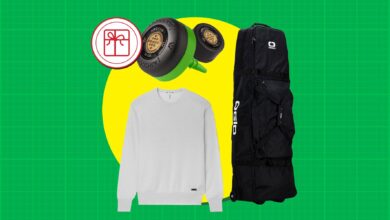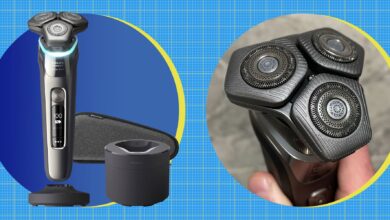The 12 Best Products to Help You Prevent and Treat Blisters

All products are independently selected by our editors. If you buy something, we may earn an affiliate commission.
Leave it to a blister (or a few) to put a serious damper on your serene neighborhood stroll or endorphin-boosting hike. These annoying bumps are caused by repeated rubbing and friction against your skin, which creates “a separation in the layers of the skin that fills with fluid,” Gabriella Vasile, MD, FAAD, a board-certified dermatologist and owner of Réforme Dermatology and Aesthetics in Charleston, South Carolina, tells SELF. While no one’s ever happy when a blister joins the party, they do actually serve a purpose (beyond letting you know you chose the wrong shoes): They protect the skin underneath, preventing an open wound from forming that could become infected.
But that doesn’t mean we have to like them—ouch! We asked dermatologists to share their top tips for choosing blister products that really help block and treat these painful spots. We’re talking bandages that stand up to sweat, socks that prevent chafing, and soothing (non-sticky!) ointments that can soothe those angry buggers. Below, we’ll walk you through everything you need to know while shopping for blister-busting remedies and drop advice from experts on how to use them.
Our top picks
- Best Bandages: Band-Aid Brand Hydro Seal Adhesive Bandages
- Best Tape: Nexcare Blister Prevention Tape
- Best Socks: Balega Hidden Comfort Performance No Show Athletic Running Socks
- Best Powder: Lush Silky Underwear Dusting Powder
- Best Pads: Dr. Scholl’s Moleskin Padding Strips
- Best Stick: Body Glide Original Anti Chafe Balm
- Best Soap: Hibiclens Antiseptic Skin Cleanser
- Best Ointment: Cetaphil Healing Ointment
FAQs about how to prevent and treat blisters
The best way to prevent blisters is by not wearing tight, uncomfortable clothing and shoes that can cause friction, Dr. Vasile says. If you know your shoes tend to rub you the wrong way—but they’re just too cute to relegate to the back of your closet—you can try preemptively applying a petroleum jelly (like Vaseline) to your skin so that the offending clothing slides instead of chafes, Dr. Vasile says.
It might sound counterintuitive, but keeping the area dry by applying a powder can also help, especially if you’re sweating a lot, because moist skin is softer and more prone to separation. Another method from Dr. Vasile: Add some sort of padding or bandage to physically create a barrier over the skin (find our favorites below).
Once you have a blister, avoid wearing the same clothes or shoes again until it heals, so you don’t cause any further damage. And don’t pop it! Most blisters will heal on their own in a few days, but popping one will lead to an open sore. “We don’t want anything turning into an infection,” Dr. Vasile says, which can look like redness, pain, or swelling. “If that does happen, we definitely recommend contacting your dermatologist and getting seen,” she adds.
If your blister breaks, keep the area clean by washing it with an antibacterial or other gentle soap, Dr. Vasile advises. Then, apply a protective or wound-healing treatment, like an ointment or petroleum jelly, and cover it with a bandage.
Best Bandages: Band-Aid Brand Hydro Seal Adhesive Bandages
Band-Aid
Brand Hydro Seal Adhesive Bandages
Pros
- Adds cushioning
- Protects wounds while absorbing excess fluid
- Stays on well
- Waterproof
Cons
- Some Amazon reviewers had issues comfortably removing it
These bandages can prevent a blister by adding a barrier to friction-prone areas, but they’ll also help an existing one stay covered (and hopefully infection-free). “It has a slight cushion effect that doesn’t add too much pressure that could trigger blister pain,” one SELF editor says. “What made me love this product more than any other bandage is that it STAYS ON. No matter how much your shoe rubs on the back of your heel, that sucker doesn’t move.” Plus, she swears her blisters heal faster when she wears one of these.
Brendan Camp, MD, FAAD, a dermatologist at MDCS Dermatology in New York, points out that these Band-Aids are waterproof hydrocolloid bandages (like many pimple patches), which means they’ll absorb any fluid that might come out of the blister and can help it heal faster.
Best Tape: Nexcare Blister Prevention Tape
Nexcare
Blister Prevention Tape
Pros
- Easy to use anywhere on the body
- Adds cushioning
- Waterproof
Cons
- Some Amazon reviewers say it comes off after hours of wear
Take it from a former ballerina- turned- SELF writer—this adhesive foam tape is the real deal.: “I used to wrap my fourth and fifth toes in it before putting on pointe shoes to keep them from rubbing against each other and the shoes, and it was pretty effective for that purpose. Which is to say, it can definitely hold up in less severe environments than standing on your toes in a box of wood,” she says. “It’s sticky, but not so sticky that it hurts when you peel it off. It’s also stretchy, flexible, and tearable, making it easy to fit it to your toe or foot shape.”
You can also lean on this tape to thwart calluses and blisters on your palms from weightlifting or other activities that are hard on your hands. Another bonus: It’s waterproof, so you don’t have to worry about it sliding around or peeling off, even when you start to sweat.
Best Socks: Balega Hidden Comfort Performance No Show Athletic Running Socks
Balega
Hidden Comfort Performance No Show Athletic Running Socks
Pros
- Shouldn’t slip down
- Very durable
- Seamless toes
- Comes in a bunch of colors
Cons
- Some Amazon reviewers say they’re too thick
Keeping your feet from getting sweaty on a long run or walk is part of the battle when it comes to fending off blisters. These socks are made of a proprietary “Drynamix” material that contains a moisture-wicking yarn, so they’ll draw sweat away from your foot. Plus, they have mesh vents to keep things breezy. “You would think, after running for four hours, that [these socks] would be dripping in sweat, but they’re not,” Jay Spector, DPM, Atlanta-based sport podiatrist, former president of the American Academy of Podiatric Sports Medicine, and marathon runner, previously told SELF.
Best Powder: Lush Silky Underwear Dusting Powder
Lush Cosmetics
Silky Underwear Dusting Powder
Pros
- Absorbs moisture
- Easy to use
- Subtle jasmine scent
Cons
- Application can be messy
Dr. Camp suggests using powders on areas that tend to trap moisture, like your groin, butt, or under your breasts. He likes this one from Lush because it’s made with absorbent cornstarch and kaolin, plus tiny shavings of cocoa butter to nourish your skin.
“I bought this product initially to help prevent blisters under my breasts from my underwires rubbing in the summer…but I’ve found it useful for so much more,” one Lush shopper wrote. “It definitely does the job of keeping you fresh and sweet smelling—I’ve even used it under my arms as a non-irritating deodorant!” It also has a light jasmine scent that reviewers can’t get enough of.
Best Pads: Dr. Scholl’s Moleskin Padding Strips
Dr. Scholl’s
Moleskin Padding Strips
Pros
- Adds cushioning
- Stays put inside shoes
- Soft material
Cons
- Not waterproof
Hikers, listen up: Moleskin should be the first thing you put in your daypack. “It’s an adhesive with a soft, protective surface that reduces skin injury and can help prevent blisters,” Dr. Camp says. And it really works—just take it from my mom, who has hiked the White Mountains in New Hampshire for years. “Moleskin can save a hiker from getting a really bad blister and also stop blood from a blister from wrecking a shoe,” she says. “It’s super important because it can allow a hiker to finish a trail without pain.”
These strips from Dr. Scholl’s are padded, but they still have enough flexibility to wrap around your heels or toes. Amazon reviewers add that they’re easy to cut into smaller pieces and sticks wherever you need them.
Best Stick: Body Glide Original Anti Chafe Balm
Body Glide
Original Anti Chafe Balm
Pros
- Fragrance-free
- Water-resistant
- Easy to pack and use
Cons
- Some Amazon reviewers say you need to reapply a lot
Dr. Camp suggests using solid or cream lubricants in drier places where your skin tends to fold and rub together, like the armpits and groin, to prevent chafing that can lead to blisters. Marisa Garshick, MD, board-certified dermatologist at MDCS Dermatology and clinical assistant professor at Cornell University, previously recommended this Body Glide stick to SELF because “it forms an invisible, dry barrier to protect the skin and can be applied anywhere there may be potential for friction.”
“I use it on my thighs and chest before long runs and haven’t had a chafing issue since,” one runner previously told SELF.
Best Soap: Hibiclens Antiseptic Skin Cleanser
Hibiclens
Antiseptic Skin Cleanser
Pros
- Cleans skin well
- Easy to use
Cons
- Some Walmart reviewers don’t like the smell
If you already have a blister, keeping it clean is super important to avoid an infection, especially when it has popped or peeled open. Dr. Vasile recommends using this pink antibacterial soap, which she and her colleagues often rely on in surgery because it’s on the stronger side. Once you’ve washed the area, she recommends following up with an ointment and a bandage.
Best Ointment: Cetaphil Healing Ointment
Pros
- Fragrance-free
- Anti-inflammatory
Cons
- Some Amazon reviewers say it’s greasy before it dries
“This multi-purpose ointment can be used to treat dry skin, chapped lips, cracked hand and heels, and minor skin irritations,” Dr. Camp says. It contains shea butter to hydrate and soften your skin, plus vitamin E, which is an anti-inflammatory that’s thought to help with wound healing. Dab some onto your blister—and to avoid getting it on your sheets or clothes (Amazon shoppers say it can be a little greasy at first), cover the area with a bandage.
More great options
When it comes to preventing or soothing blisters, you can never have too many remedies in your toolkit. Below, shop even more options from our experts.
Lansinoh Lanolin Nipple Cream
Lansinoh
Lanolin Nipple Cream
Pros
- Reduces friction
- Moisturizes skin
- Relieves itchiness
Cons
- Some Amazon reviewers say it’s too thick
This nipple cream has multiple purposes (just ask Kylie Jenner, who uses it as lip balm). According to Dr. Camp, you can also add blister protection to the list. Its star ingredient is lanolin, an oil from sheep’s wool that’s often used in skin care products to moisturize and relieve itchiness. When you’re not actively fighting off blisters, you can slather it on dry, cracked lips or hands too.
Aquaphor Healing Balm Stick
Aquaphor
Healing Balm Stick
Pros
- Moisturizes skin
- Quick to apply
- Fragrance-free
Cons
- Some Amazon reviewers say they expected more product in the tube
This 2024 Healthy Beauty Award–winning balm combines the convenience of a stick applicator with the same hydrating ingredients you know and love in Aquaphor, like glycerin, panthenol, and bisabolol. You can use it as a moisturizer on parched skin, like our tester often does, and as a blister blocker. “I am a lifelong Aquaphor groupie, particularly because I get awful eczema on the backs of my hands in the winter,” they say. “The balm stick is a game changer; it’s mess-free and it couldn’t be easier to apply after every hand wash.”
Anti Monkey Butt Anti-Friction Powder
Anti Monkey Butt
Anti-Friction Powder
Pros
- Soaks up moisture
- Relieves itch
- Good for sensitive skin
Cons
- Application can be messy
Here’s another powder worth considering, especially if you have sensitive skin. Ife Rodney, MD, board-certified dermatologist and founding director of Eternal Dermatology Aesthetics in Fulton, Maryland, previously recommended it to SELF because it uses cornstarch to absorb moisture instead of talc, an ingredient that can irritate sensitive skin. It also contains kaolin to soak up sweat that might otherwise cause blisters, plus it has calamine in it to relieve soreness and itchiness. Dust a little in your socks and you’re good to go.
Vaseline Original Petroleum Jelly
Vaseline
Original Petroleum Jelly
Pros
- Fragrance-free
- Multipurpose
- Comes in a bunch of sizes
Cons
- A little greasy
We’ve mentioned a few creams and ointments that can help make your skin slicker, but we still have to shout out the OG: Vaseline. Dr. Vasile recommends using petroleum jelly as both a way to prevent blisters and a way to keep wounds protected from potential irritants that could cause an infection. Applying a bandage on top adds another layer of defense, for happy feet all day long.
Get more of SELF’s stellar product recommendations delivered right to your inbox (for free!).
Related:



